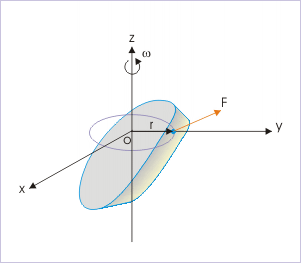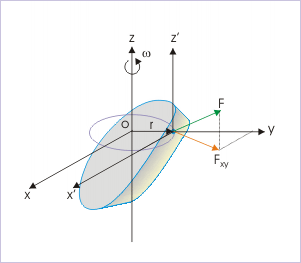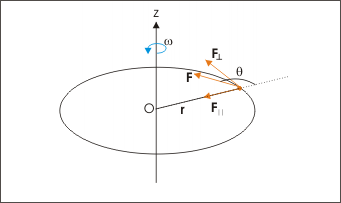| << Chapter < Page | Chapter >> Page > |
These factors, which cause rotation, are captured by a quantity known as torque, which is defined as :
where " r " is the position vector. There is a slight difficulty in interpreting this vector equation as applicable to rotation. The position vector," r ", as we can recall, is measured from a point. Now, the question is what is that point in the case of rotation about a fixed axis? Here, we observe that there is a unique point of application of the force. By the nature of motion, this point rotates in a plane perpendicular to the axis of rotation. We can, therefore, uniquely define the position of the point of application of force by measuring it from the point on the axis in that plane of rotation.
Rotational motion

The force may be directed in any possible direction. However, the body rotates about a fixed axis. It is not allowed to rotate or move about any other axes. What it means that we are limited only to the component of torque along the axis of rotation. It, then, means that we are only interested in components of force that lie in the plane of rotation, which is perpendicular to the axis of rotation. This we achieve by ensuring to only consider the components of force which are perpendicular to the axis of rotation i.e. in the plane of rotation. In the figure below, we have tried to capture this aspect. We consider only the component of force in xy-plane while evaluating the vector torque equation given above.
Rotational motion

In the nutshell, we interpret the vector product with two specific conditions :
The rotation of the rigid body about an axis passing through the body itself is composition of very large numbers of circular motions by particles composing it. Each of the particles undergo circular motion about the axis in a plane which is perpendicular to it.
With the understandings as deliberated above, let us determine the magnitude of torque. Here, let us consider that a force is applied at a point which is at a perpendicular distance "r" from the axis and in the plane of rotation. As far as application of force is concerned, it is a force applied at a point in the plane of rotation. In order to keep the context simplified, we have not drawn the rigid body assuming that the point of application rotates in a circle whose plane is perpendicular to the axis of rotation. Now, the magnitude of torque is given as :
Torque

where "r","F" and "θ" are quantities measured in the plane perpendicular to the axis of rotation.
Equivalently, we can determine the magnitude of torque as :
The magnitude of torque is equal to the product of the magnitude of position vector as drawn from the center of the circle and component of force perpendicular to the position vector. This is an important interpretation as it highlights that it is the tangential or perpendicular component (perpendicular to radial direction) of force, which is capable to produce change in the rotation. The component of force in the radial direction (F cosθ) does not affect rotation. We can also rearrange the expression of magnitude as :

Notification Switch
Would you like to follow the 'Physics for k-12' conversation and receive update notifications?